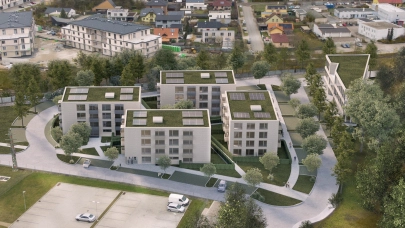
As the global pandemic progresses across borders and within countries, Cushman & Wakefield’s EMEA market research experts shared what they are seeing on the ground in their countries.
Czech Republic – Marie Baláčová, Head of Research
Shortly after the first confirmed cases in the Czech Republic at the beginning of March, and prior to many other countries in Europe, the Czech government gradually introduced strict measures to prevent an outburst of COVID-19, including the obligatory wearing of face masks, closed borders, schools and most shops. Subsequently, the number of patients among the most vulnerable elderly people as well as the number of dead is still relatively small, and the Czech healthcare system seems to cope with the challenge well.
The government has provided relief and compensation for Czech businesses. The Czech Republic had one of the lowest levels of public debt and unemployment in the EU before the crisis which promises a comparatively fast recovery for the Czech economy after the crisis.
However, many companies are able to continue their business: the office-based professions have successfully moved to the home office and e-commerce operators report up to four times the turnover they normally see this time of a year. We are witnessing an unprecedented social cohesion in the whole Czech Republic with the common motto “We can do it together”.
Hungary – Orsolya Hegedűs, Head of Research and Consultancy
Hungary has been in lockdown since 28 March. Car manufacturers including Audi, BMW, Mercedes and Suzuki have temporarily closed production. Most office occupiers have shifted to home office. Social distancing measures are in place and shopping hours for seniors was introduced. By decree, leisure and entertainment venues have all closed and people are only allowed out to shop for groceries, do basic errands or obtain medical supplies, and exercise in the open. Whilst the government has not enforced non-essential shop closure, as a result of a dramatic decline in sales, many retailers have opted for voluntary shut down in recent days. Most shopping centres are open but operate under tightened opening hours.
The Hungarian government has announced a financial aid package and more is expected to follow this week. It includes a blanket moratorium on loan repayments for all companies and private borrowers until the end of the year and measures to defend jobs, including payroll tax cuts for the most heavily affected sectors, such as tourism and entertainment among others.
In the meantime, the National Bank of Hungary has left the base rate unchanged and will increase the available liquidity of the banking system by €7.1 billion (HUF 2,600 billion).
Poland – Katarzyna Lipka-Nawrocka, Manager of the Consulting and Research team
Since 14 March all shopping centre operations have been limited to stores only selling essentials or providing essential services, including grocery stores, pharmacies and launderettes. On 25 March Poland went into full lockdown with the public banned from leaving homes except for essential reasons. Restaurants are only allowed to offer delivery or takeaway meals. Standalone DIY markets remain open. The Polish Government adopted the assumptions of an ‘anti-crisis shield’ according to which lease agreements in shopping centres should be suspended for stores that are not allowed to operate. Both tenants and landlords are taking the initiative to incorporate the interests of both parties in the new regulations.
We are currently observing adaptation processes in the warehouse market in Poland, especially visible on the demand side, as the development processes started last year are still ongoing. Companies from the e-commerce, food, FMCG, pharmaceutical, hygiene or cleaning products sectors are looking for solutions to meet the sudden increase in consumer demand. Tenants are increasingly interested in short-term leases, due, in part, to the bullwhip effect thanks to recent consumer stockpiling.
In the first quarter of 2020, tenant activity in the Polish office market was at a relatively stable level. Nonetheless, since mid-March, approximately 5-10% of transactions are on hold due to general uncertainty caused by COVID-19. Currently, there is no legislation limiting construction works in Poland and most of the office construction sites continue.
Total investment volume recorded by the end of March 2020 in Poland exceeded €1.1 billion and it has been mostly driven by the industrial sector (€800 million). We can observe that deals in advanced stages are still pushing ahead and closing, however, most investors have taken a ‘wait-and-see’ position. We expect a further slowdown of investor activity as we come into Q2. Credit activity has partially slowed down. Banks are taking a different approach to financing specific sectors, with most optimism directed at logistics property.
Slovakia – Juraj Bronček, Research Analyst
The new Slovak government will help companies and sole traders maintain jobs with measures that will cost €1 billion per month (around 1% of Slovakia's annual GDP) and bank guarantees for €500 million per month. This business relief is conditional on the beneficiaries undertaking not to lay off their employees.
The state will provide contributions to sole traders and employees in whose businesses have been forced to close as well as their direct suppliers. The sum of the government’s contribution will depend on how far sales have dropped. The state will also reimburse 55% of gross wage to workers on quarantine or nursing leave. In addition, the government has agreed to conditionally postpone the payment of taxes and levies and the application of tax losses from previous periods.
The commercial real estate sector is witnessing the postponement of both investment transactions and rental contracts. Most existing construction projects are postponed for later periods as well. We are yet to see a change in pricing in connection with the pandemic. The retail sector, however, expects an already anticipated prime rent and yield correction in relation to retail saturation reaching a peak in the capital.



